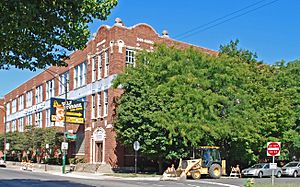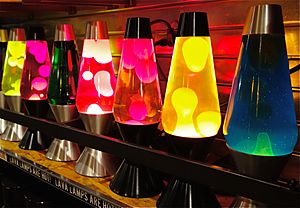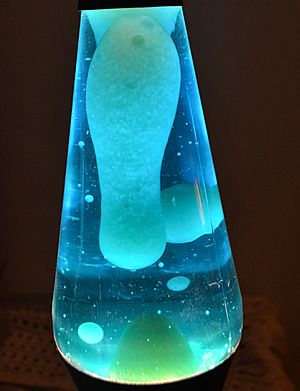Lava lamp facts for kids
A lava lamp is a cool, decorative light that was invented in 1963 by a British businessman named Edward Craven Walker. He also started the company Mathmos. The lamp has a special colored wax mixture inside a glass bottle. The rest of the bottle is filled with clear or see-through liquid. The bottle sits on a base that holds a light bulb. The heat from the bulb makes the wax less dense, so it floats up. As the warm wax rises, it cools down and becomes heavier again, then it sinks back to the bottom. This cycle looks a lot like real lava flowing, which is how the lamp got its name! Lava lamps come in many different styles and colors.
Contents
How a Lava Lamp Works
A classic lava lamp uses a regular light bulb to heat up a tall glass bottle. Inside, there's water and a special mix of wax. This wax is designed to be just a little bit heavier than the water when it's cold.
When the light bulb heats the wax, the wax gets warmer and expands. This makes it lighter (less dense) than the water around it. Because it's lighter, blobs of wax start to float up to the top of the lamp.
As the wax blobs reach the top, they cool down. When they cool, they become heavier (more dense) again. This causes them to sink back down to the bottom. At the bottom, a metal coil helps the cooled wax blobs join back together. Then, the cycle starts all over again as the wax gets heated up by the bulb.
It usually takes about 45 to 60 minutes for the wax to warm up enough to start moving freely, especially if your room is at a normal temperature. If the room is colder, it might take 2 to 3 hours for the lamp to get going.
What Happens if You Shake It?
It's important not to shake or knock over a lava lamp when it's warm and the wax is moving. If you do, the wax and liquid might mix together and become cloudy. This is called emulsifying. If this happens, the liquid around the wax blobs won't be clear anymore.
To fix it, you need to turn the lamp off and let it cool down completely for a few hours. The wax will settle back to the bottom and form one big blob again. For really cloudy lamps, you might need to turn it on and off several times over a few days to make it clear again.
Newer Lava Lamp Designs
In 2015, a new type of lamp came out that uses something called ferrofluid instead of wax. Ferrofluid is a special liquid that reacts to magnets, making for a different kind of cool display!
The Story of the Lava Lamp

The idea for the lava lamp came to Edward Craven Walker in 1963. He was in a pub and saw a homemade egg timer bubbling on a stove. It was made from a cocktail shaker filled with liquids. This gave him the idea for the lava lamp!
He hired an inventor named David George Smith to help him create the device and figure out the right chemical mix. Smith is credited as the inventor on the original patent for the "Display Device."
Craven Walker's company was called Crestworth, and it was located in Poole, England. He named his new lamp "Astro." He also made smaller versions like the "Astro Mini."
Lava Lamps Come to America
In 1965, two men from America, Adolph Wertheimer and Hy Spector, saw Walker's lamps at a trade show in Germany. They loved them so much that they bought the rights to sell them in the United States. They started a company in Chicago called Lava Manufacturing Corporation and called their product the Lava Lite Lamp.
Later, in the late 1970s, the American rights were sold to Larry Haggerty. His company, Lava World International, made American lava lamps for over 30 years.
Over time, the company that made American lava lamps changed hands a few times. In 2018, a toy and gift company called Schylling Inc. bought the 'Lava Lamp' brand. They still own the rights to the name and shape of LAVA© lamps in the US today.
Lava Lamps Around the World
Edward Craven Walker kept the rights to sell lava lamps in the rest of the world. In the late 1980s, he partnered with Cressida Granger and David Mulley. Eventually, Granger and Mulley took over the company and changed its name to Mathmos in 1992. Edward Craven Walker continued to help out as a consultant until he passed away in 2000.
Mathmos still makes lava lamps and similar products today. Their original "Astro" lava lamp celebrated its 50th anniversary in 2013. Mathmos lava lamps are still made in the same factory in Poole, England, where they first began!
See also
 In Spanish: Lámpara de lava para niños
In Spanish: Lámpara de lava para niños




